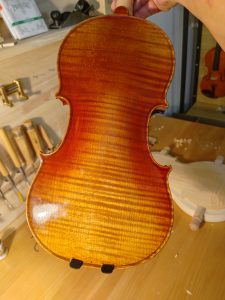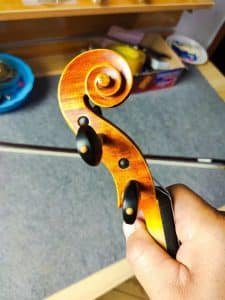Violin Tuning Methods and Techniques
Violin Tuning Methods and Techniques
Tone intonation is very important for violin playing, no matter how the playing technique, the most basic intonation must be guaranteed, how can a beginner violin tune the strings? This article summarizes the tuning methods and techniques.
How to tune a violin using a piano
If you want to tune a violin with a piano, it's really not that hard. Simply find the piano note that corresponds to the string you want to tune on your violin. Then use the fine tuner on the violin to adjust if the string is off by less than a semitone. You can also use the pedals on the piano, which sounds clearer and frees up your hands to tune the violin.
Tuning a violin with a tuner
An electronic tuner can also tune a violin. The tuner provides a way to double-check that the D, G, and E strings are tuned correctly based on the tuned A string. Most electronic tuners are calibrated for standard 440 A, but some can provide tuning feedback for non-standard A as well. After tuning your instrument correctly, you can use violin rosin to further enhance the playing experience.
How often are the strings tuned?
Violin strings should be tuned before every practice or performance. Depending on the climate and how often the violin is played, it may need to be tuned more frequently. If a violin is played frequently, it may stay in tune longer than if it is played occasionally. The strings may also go out of tune if the violin is stored in a place with drastic changes in temperature or humidity.
Tuning with Tuning Forks
Using a tuning fork is easy. Start by tapping the tuning fork against a soft object such as your knee. Hold the tuning fork close to your ear and pluck the strings. The notes you hear should match the notes coming from the tuning fork. If it doesn't, you know your strings are out of tune.
fine tuning
The four tuning pegs on the top of the violin control the tension of the four strings. To tune a violin, you turn the pegs to tighten or loosen the strings until they reach the correct pitch. Start with the lowest string (the string with the thickest, deepest sound). Turn the spindle until the string is in tune. Move to the next string and repeat the process.
First make sure the A string is in tune. Then play the A and D strings together and listen for fifths in tune. Then play the D and G strings together and the A and E strings. It is important to recognize the desired sound by ear or to observe how the strings vibrate when played together.
Tuning Tips:
Don't tune the strings directly upwards by turning the axle, put them down first and then tune them up, the same for all four strings. Here the so-called high and low up and down refers to the pitch, turn the sound toward the headstock will be high, and vice versa is low, this is to avoid accidentally will be tuned off the string, but also better tuning.
Turning the string spindle requires inward pressure, i.e., to the right when tuning the G and D strings, and to the left when tuning the A and E strings. If you look at the string spindles individually, you will see that one side is thicker and the other side is thinner. The corresponding holes in the string box are also small and large. When tuning the strings, you need to turn the strings tightly, the strings have a certain amount of tension, and if you don't press them inward, the string shafts will come loose, so you need to pay special attention to this point. Whether or not the string shaft is good for tuning involves the material of the string shaft, whether or not the string shaft hole is horizontal, and whether or not the thickness of the string shaft and the slope of the string shaft hole correspond to each other and fit together. Another suggestion is to ask the store to put wax on the string spindles when you buy the instrument. The wax is very helpful in making the string spindles turn smoothly.
Characteristics of violin strings
It's also important to know a little bit about the characteristics of the strings when you're learning. It is not a good idea to keep the strings taut for a long period of time without playing them, i.e., it is not a good idea to keep the strings at the pitch of the strings. Therefore, the store usually just install the strings on the instrument, to ship the time to tune, and the strings have a physical characteristic, the strings were originally in a relaxed state, when we tuned to the state of the pitch, the strings from the loose suddenly taut, and then began to relax, that is, the tone began to become lower, when tuning the A-string in the tuning of the D-string, tuning G-string back to look at the A-string has become lower, had to be re-tuned, and so on and so forth. To be very stable, it takes hours or days. Therefore, it is normal to buy a violin from a store that has already tuned it, but when you get home, you find that the tone has run away, and this is even more true of the violin purchased on the Internet. We would like to explain this to avoid any misunderstanding and to build up an understanding of the strings. Afterwards, you will often encounter problems such as: the strings are broken, you need to change the strings, you have just tuned the instrument, but the sound is gone, etc. Is there a problem with the instrument? Is there something wrong with the instrument? No, this is a physical phenomenon of the strings.
Hopefully, these methods and tips will help you get better at violin tuning and make your playing more dynamic.

![Nanjing Laoyu Handmade Violin Making Studio-[Avoid Pitfalls]](https://www.xytiqin.com/wp-content/uploads/2023/08/2023082215564289-147x300.png)


